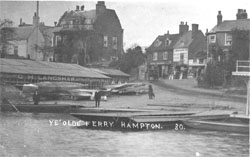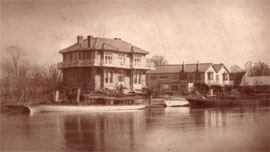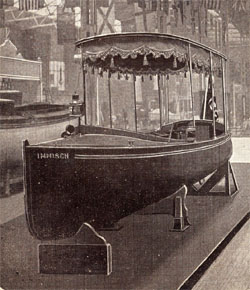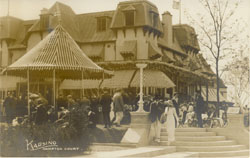The Riverside at Hampton
Ferries, boat building and a casino

Hampton takes its name from the Anglo-Saxon words meaning 'the settlement in the bend of the river'. The Domesday Book of 1086 mentions fishing-nets and drag-nets in the River Thames here. Hampton Ferry, crossing to Molesey, was in existence in 1519, and probably earlier. Boat building took place beside the ferry. Thomas Spicer, boat-builder of Hampton, made his will on 10 Dec 1675. It was proved the following year and by it he bequeathed the lease of the ferry to his wife Prudence. He also left to his son Jacob 'All the rest of working tools and utensils belonging to the boats' and 'gives him the boat (named) David'.
The Thames has not always been the navigable river we know today. There were shallows, stakes and other obstructions used in connection with fishing. Water levels were reduced by extraction by mills. All this made problems for river traffic and commercial barges. At other times there were floods and the worst flood of the 18th century along the Thames Valley had its nominal high point on 12 Mar 1774. On this occasion deep frost had led to frozen ground, followed by heavy snow, and then a rapid thaw with heavy rain caused extensive flooding. Flood marks in Hampton and Twickenham recorded the event. The lock system of the upper Thames was only developed from 1770 and the pound lock at Molesey, just above Hampton Court Bridge, was not built until 1815.

At Hampton the riverside changed dramatically after 1852 when three water companies (the Southwark and Vauxhall, the Grand Junction and the West Middlesex) established works here. A coal wharf for barges was built in 1855 to handle the daily delivery of more than 100 tons of coal to fire the pumping stations. An even larger coal wharf was built in 1877.
During the 19th century the river became a focus for leisure pursuits. A Watermen's Regatta was established in 1835 and ran until 1910. The Molesey Amateur Regatta was founded in 1867 and is still run today. In 1883 this regatta was described as “holding second place to Henley Regatta alone, to which, in fact, it bids fair to become a formidable rival”. A rowing club was founded in 1871, by which time Hampton Grammar School was making a name for itself as a rowing school.

Boat building increased through the 1870s, acquiring an international reputation. Tom Tagg had moved to what is now known as Tagg's Island where he built the Island Hotel. Within a few years he was supplying boats to the Royal Family, the Russian Royal Family, to Egypt and other distant places. The firm of Constables established two yards in Hampton, one opposite Tagg's Island in Hampton Court Road and the other beside Thames Street.
There have always been a number of islands in the river at Hampton. They have altered in size and shape over the years with changing river conditions and dredging, sometimes renamed following new ownership. Today, starting from upstream, the local islands are known as Platt's Eyot, Benn's Eyot, Garrick's Ait, Duck's Eyot, Tagg's Island and Ash Island.

Until the 1880s Platt's Eyot provided osiers for basket making. In 1888 Moritz Immisch, established a boatyard. A fleet of electric hire launches was built, and a number of floating charging stations were installed to increase the range over which the boats could operate. In 1913, Thornycrofts acquired the yard, changing the name to the Hampton Launch Company. During World War 1 the yard built a large number of fast craft for the military, including torpedo-carrying Coastal Motor Boats (CMBs). In World War 2 Motor Torpedo Boats (MTBs) and other fast launches were built. Throughout the period boats were built to the very highest standards, including 'Miss England III' for Lord Wakefield. This boat achieved a world water speed record of 119.81 mph on Loch Lomond in 1932. In the 1960s Thornycrofts were taken over by Vosper and boat building ceased.

In 1912 Tom Tagg's Island Hotel was replaced by the Karsino Hotel and entertainment complex, built by Fred Karno. Demolished in 1971, a lagoon was formed in the centre of the island to provide mooring for additional houseboats, which have been associated with the island since the 1880s.




